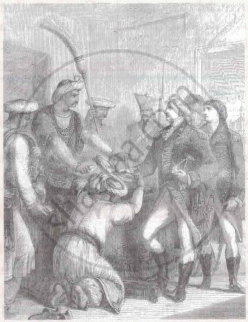Advertisements
Advertisements
प्रश्न
Answer the following question briefly:
Mir Qasim was a competent ruler, determined to free himself from foreign control. In this context answer the following:
Trace the events from the outbreak of war (1763) between Mir Qasim and the British up to the Battle of Buxar in 1764.
उत्तर
The employees of the Company misused their trade privileges. They sold their duty-free trade permits to Indian merchants who also used them to carry on duty-free trade. This deprived the nawab of large revenues and was unfair to those local merchants who had to pay heavy duties.
To put an end to the corrupt practices of the British, Mir Qasim abolished all duties on internal trade. This made the British furious. They refused to accept an equal status with j the Indian merchants.
In 1763, war broke out between Mir Qasim and the British. The Nawab was defeated. Mir Jafar was reinstated on the throne.
Mir Qasim was determined to recover his throne. He escaped to Awadh, where he formed an alliance with Shuja-ud-Daulah, the nawab of Awadh, and the Mughal emperor, Shah Alam II.
The combined forces of the three allies clashed with the Company’s troops at Buxar in 1764 and were decisively defeated by the British.
संबंधित प्रश्न
Fill in the blanks:
In 1717, the Mughal emperor granted the United East India Company the right to carry on duty-free trade in __________, ________, and ________.
Fill in the blanks:
Bengal in the 18th century was the _______ and the most _________ province in India.
Choose the correct answer:
The largest and most prosperous European settlement in Bengal was the British settlement at ___________.
This picture portrays a momentous event in 1765, involving a British Governor and a Mughal emperor wherein the Mughal emperor is conveying the grant of the Diwani to the governor.

Give a brief account of the battle that preceded this event. When did it take place?
What plot did Robert Clive hatch to remove Siraj-ud- Daulah?
Match the Contents of Column A Column B.
| Column A | Column B |
| 1. Shuja-ud-daulah | (a) Nawab of Bengal |
| 2. Shah Alam II | (b) Founder of British Empire in India |
| 3. Mir Qasim | (c) 1765 |
| 4. Siraj-ud-daulah | (d) 1765–1772 |
| 5. Battle of Plassey | (e) Calcutta |
| 6. Battle of Buxar | (f) Formed an alliance with the Mughal Emperor and Nawab of Awadh. |
| 7. Grant of Diwani | (g) Mughal Emperor |
| 8. Dual Government | (h) Nawab of Awadh |
| 9. Clive | (i) 1757 |
| 10. Forth William | (j) 1764 |
Answer the following question:
Why did Mir Jafar enter into a conflict with the English East India Company?
Answer the following question:
Describe the circumstances that led to the Battle of Buxar.
Answer the following question:
What were the results and significance of the Battle of Buxar?
Answer the following question:
What were the causes and results of the First Anglo-Maratha War? When was it fought?
